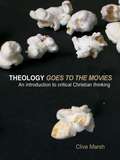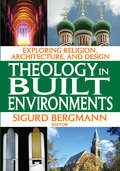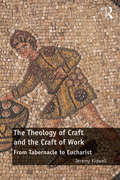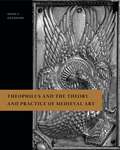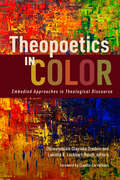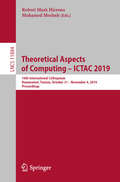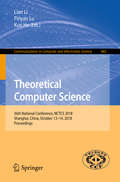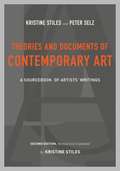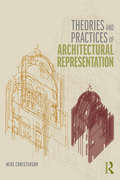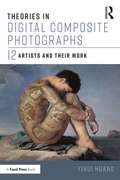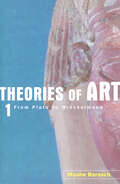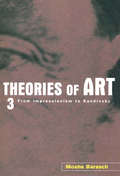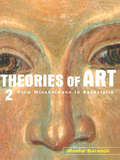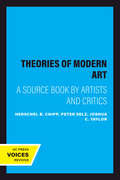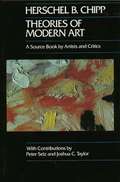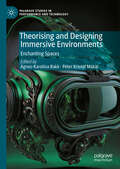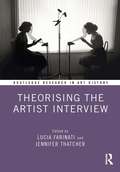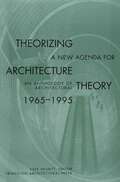- Table View
- List View
Theology Goes to the Movies: An Introduction to Critical Christian Thinking
by Clive MarshDrawing a comparison between religion and cinema-going, this text examines a range of contemporary films in relation to key theological concepts. Cinema as a religion-like activity is explored through cognitive, affective, aesthetic and ethical levels, identifying the religious aspects in the social practice of cinema-going. Written by a leading expert in the field, Theology Goes to the Movies analyzes: the role of cinema and Church in Western culture the power of Christian symbols and images within popular culture theological concepts of humanity, evil and redemption, eschatology and God. This is an ideal text for students seeking a new way into the study of theology.
Theology in Built Environments: Exploring Religion, Architecture and Design
by Sigurd BergmannBuilt space is both a physical entity as well as a socially and historically constructed place. It constantly interacts with human beings, affecting their behavior, thinking, and feeling. Doing religious work in a particular environment implies acknowledging the surroundings to be integral to theology itself. The contributors to this volume view buildings, scriptures, conversations, prayers, preaching, artifacts, music and drama, and built and natural surroundings as contributors to a contextual theology.The view of the environment in which religion is practiced as integrated with theology represents not just a new theme but also a necessity if one is to understand religion's own depth. Reflections about space and place and how they reflect and affect religious experience provide a challenge and an urgent necessity for theology. This is particularly important if religious practitioners are to become aware of how theology is given expression in the existential spatiality of life. Can space set theology free? This is a challenging question, one that the editor hopes can be answered, at least in part, in this volume.The diversity of theoretical concepts in aesthetics, cultural theory, and architecture are not regarded as a problem to be solved by constructing one overarching dominant theory. Instead, this diversity is viewed in terms of its positive potential to inspire discourse about theology and aesthetics. In this discourse, theology does not need to become fully dependent on one or another theory, but should always clearly present its criteria for choosing this or that theoretical framework. This volume shows clearly how different modes of design in sacred spaces capture a sense of the religious.
The Theology of Craft and the Craft of Work: From Tabernacle to Eucharist
by Jeremy KidwellAn important reconceptualisation is taking place in the way people express creativity, work together, and engage in labour; particularly, suggests Kidwell, a surprising resurgence in recent years of manual and craft work. Noting the wide array of outlets that now market hand-made goods and the array of popular books which advocate ‘making’ as a basis for activism or personal improvement, this book seeks to understand how the micro-politics of craft work might offer insights for a broader theology of work. Why does it matter that we do work which is meaningful, excellent, and beautiful? Through a close reading of Christian scripture, The Theology of Craft and the Craft of Work examines the theology and ethics of work in light of original biblical exegesis. Kidwell presents a detailed exegetical study of temple construction accounts in the Hebrew bible and the New Testament. Illuminating a theological account of craft, and employing the ancient vision of ‘good work’ which is preserved in these biblical texts, Kidwell critically interrogates modern forms of industrial manufacture. This includes a variety of contemporary work problems particularly the instrumentalisation and exploitation of the non-human material world and the dehumanisation of workers. Primary themes taken up in the book include agency, aesthetics, sociality, skill, and the material culture of work, culminating with the conclusion that the church (or ‘new temple’) is both the product and the site of moral work. Arguing that Christian worship provides a moral context for work, this book also examines early Christian practices to suggest a theological reconceptualisation of work.
Theology of the Arts: Encountering God through Music, Art and Rhetoric
by Richard ViladesauThis book explores, in a timely and engaging manner, several aspects of the relations between theology and aesthetics, in both the pastoral and academic realms. The underlying motif of this work is that beauty is a means of divine revelation, and that art is the human mediation that both enables and limits its revelatory power. Although aimed at undergraduate theology students, it will certainly capture the interest of art students, pastoral ministers and anyone who appreciates the arts.
Theophilus and the Theory and Practice of Medieval Art
by Heidi C. GearhartIn this study of the rare twelfth-century treatise On Diverse Arts, Heidi C. Gearhart explores the unique system of values that guided artists of the High Middle Ages as they created their works.Written in northern Germany by a monk known only by the pseudonym Theophilus, On Diverse Arts is the only known complete tract on art to survive from the period. It contains three books, each with a richly religious prologue, describing the arts of painting, glass, and metalwork. Gearhart places this one-of-a-kind treatise in context alongside works by other monastic and literary thinkers of the time and presents a new reading of the text itself. Examining the earliest manuscripts, she reveals a carefully ordered, sophisticated work that aligns the making of art with the virtues of a spiritual life. On Diverse Arts, Gearhart shows, articulated a distinctly medieval theory of art that accounted for the entire process of production—from thought and preparation to the acquisition of material, the execution of work, the creation of form, and the practice of seeing.An important new perspective on one of the most significant texts in art history and the first study of its kind available in English, Theophilus and the Theory and Practice of Medieval Art provides fresh insight into the principles and values of medieval art making. Scholars of art history, medieval studies, and Christianity will find Gearhart’s book especially edifying and valuable.
Theophilus and the Theory and Practice of Medieval Art
by Heidi C. GearhartIn this study of the rare twelfth-century treatise On Diverse Arts, Heidi C. Gearhart explores the unique system of values that guided artists of the High Middle Ages as they created their works.Written in northern Germany by a monk known only by the pseudonym Theophilus, On Diverse Arts is the only known complete tract on art to survive from the period. It contains three books, each with a richly religious prologue, describing the arts of painting, glass, and metalwork. Gearhart places this one-of-a-kind treatise in context alongside works by other monastic and literary thinkers of the time and presents a new reading of the text itself. Examining the earliest manuscripts, she reveals a carefully ordered, sophisticated work that aligns the making of art with the virtues of a spiritual life. On Diverse Arts, Gearhart shows, articulated a distinctly medieval theory of art that accounted for the entire process of production—from thought and preparation to the acquisition of material, the execution of work, the creation of form, and the practice of seeing.An important new perspective on one of the most significant texts in art history and the first study of its kind available in English, Theophilus and the Theory and Practice of Medieval Art provides fresh insight into the principles and values of medieval art making. Scholars of art history, medieval studies, and Christianity will find Gearhart’s book especially edifying and valuable.
Theopoetics in Color: Embodied Approaches in Theological Discourse
by Oluwatomisin Olayinka Oredein and Lakisha R. Lockhart-RuschA collaborative book project centering the liberative theopoetics practiced by a new generation of scholars of color What is theopoetics? Once a field dominated by white liberals in the ivory tower, this embodied form of theology has flourished in the work of a new generation of scholars of color. In this groundbreaking book edited by Oluwatomisin Olayinka Oredein and Lakisha R. Lockhart-Rusch, a diverse team of theologians shows how theopoetics can be practiced &“in color.&” Featuring unconventional and artistic forms of religious reflection, this collection demonstrates how theology can become accessible when it reflects the embodied experiences of marginalized people and communities. These creative contributions defy the limitations of the white, Eurocentric academy, including such works as: • an explanation on the use of experimental theater to express theological theses • a guide to spiritual disciplines for metaphorical cyborgs seeking liberation • a meditation on the theological import of Filipino potlucks • a literary reflection on the meaning of religion to Black boys and men Diverse in scope and radical in perspective, this bold volume reclaims the liberative potential of theopoetics. Scholars and students of theology and the arts will discover inspiring new methodologies and fresh ideas in these pages. Contributors: Brian Bantum, Yara González-Justiniano, James Howard Hill Jr., Carolina Hinojosa-Cisneros, Yohana Agra Junker, Peace Pyunghwa Lee, Lakisha R. Lockhart-Rusch, Oluwatomisin Olayinka Oredein, Patrick B. Reyes, Joyce del Rosario, Tiffany U. Trent, Tamisha A. Tyler, Lis Valle-Ruiz
Theoretical Aspects of Computing – ICTAC 2019: 16th International Colloquium, Hammamet, Tunisia, October 31 – November 4, 2019, Proceedings (Lecture Notes in Computer Science #11884)
by Robert Mark Hierons Mohamed MosbahThis book constitutes the refereed proceedings of the 16th International Colloquium on Theoretical Aspects of Computing, ICTAC 2019, held in Hammamet, Tunisia, in October/November 2019.The 17 revised full papers presented together with 2 keynote papers and 1 industrial paper were carefully reviewed and selected from 138 submissions.The papers are grouped in topical sections on models and transition systems; real-time and temporal logics; verification and concurrency; privacy and security; equations, types, and programming languages.
Theoretical Computer Science: 39th National Conference of Theoretical Computer Science, NCTCS 2021, Yinchuan, China, July 23–25, 2021, Revised Selected Papers (Communications in Computer and Information Science #1494)
by Zhiping Cai Jian Li Jialin ZhangThis book constitutes the thoroughly refereed proceedings of the 39th National Conference of Theoretical Computer Science, NCTCS 2021, held in Yinchuan, China, in July 2021. The 67 full papers were carefully reviewed and selected from 145 submissions, and 14 of them were selected for the volume. The papers present recent research in the areas of information hiding, data detection and recognition, system scheduling, time series prediction, and formal analysis.
Theoretical Computer Science: 36th National Conference, NCTCS 2018, Shanghai, China, October 13–14, 2018, Proceedings (Communications in Computer and Information Science #882)
by Lian Li Pinyan Lu Kun HeThis book constitutes the thoroughly refereed proceedings of the National Conference of Theoretical Computer Science, NCTCS 2018, held in Shanghai, China, in October 2018. The 11 full papers presented were carefully reviewed and selected from 31 submissions. They present relevant trends of current research in the area of algorithms and complexity, software theory and method, data science and machine learning theory.
Theorie und Theater: Zum Verhältnis von wissenschaftlichem Diskurs und theatraler Praxis (Kulturelle Figurationen: Artefakte, Praktiken, Fiktionen)
by Astrid Hackel and Mascha VollhardtDie Theaterwissenschaft beruft sich gern auf den gemeinsamen Ursprung von Theorie und Theater. Ein Grund zu fragen, auf welche Weise akademische Diskurse Eingang in zeitgenössische Performances, Tanz- und Theaterinszenierungen finden und was diese umgekehrt zur Vermittlung oder sinnlichen Fremdwerdung theoretischen Wissens beitragen können. Untersucht werden die zahlreichen Verflechtungen und Unwägbarkeiten zwischen Theorie und Theater, die szenische Selbstreferenzialität und Widerständigkeit gegen die eigene Theoretisierbarkeit, die Herausforderungen im Umgang mit humanwissenschaftlichen, (post-)feministischen und queeren Theorien sowie der Stellenwert von Sprache, Sinn und Sinnlichkeit in zeitgenössischen Inszenierungen.
Theorie und Theater
by Astrid Hackel Mascha VollhardtDie Theaterwissenschaft beruft sich gern auf den gemeinsamen Ursprung von Theorie und Theater. Ein Grund zu fragen, auf welche Weise akademische Diskurse Eingang in zeitgenössische Performances, Tanz- und Theaterinszenierungen finden und was diese umgekehrt zur Vermittlung oder sinnlichen Fremdwerdung theoretischen Wissens beitragen können. Untersucht werden die zahlreichen Verflechtungen und Unwägbarkeiten zwischen Theorie und Theater, die szenische Selbstreferenzialität und Widerständigkeit gegen die eigene Theoretisierbarkeit, die Herausforderungen im Umgang mit humanwissenschaftlichen, (post-)feministischen und queeren Theorien sowie der Stellenwert von Sprache, Sinn und Sinnlichkeit in zeitgenössischen Inszenierungen.
Theories and Documents of Contemporary Art: A Sourcebook of Artists' Writings
by Kristine Stiles Peter SelzAmbitious and interdisciplinary, this long-awaited collaboration is a landmark presentation of the writings of contemporary artists. These influential essays, interviews, and critical and theoretical comments provide bold and fertile insights into the construction of visual knowledge. Featuring a wide range of leading and emerging artists since 1945, the collection—while comprehensive and authoritative—offers the reader some eclectic surprises as well.
Theories and Documents of Contemporary Art
by Kristine Stiles Peter Howard SelzAmbitious and interdisciplinary, this long-awaited collaboration is a landmark presentation of the writings of contemporary artists. These influential essays, interviews, and critical and theoretical comments provide bold and fertile insights into the construction of visual knowledge. Featuring a wide range of leading and emerging artists since 1945, the collection--while comprehensive and authoritative--offers the reader some eclectic surprises as well.
Theories and Practices of Architectural Representation
by Mike ChristensonTheories and Practices of Architectural Representation focuses on the study of architectural knowledge approached through the lens of representation: the making of things-about-buildings. Architectural knowledge systems continue to shift away from traditional means, such as books and photographs, into modes dominated by digital technologies. This shift parallels earlier ones developed by craftspeople into the knowledge of painters and writers, or shifts from manually produced knowledge into the mode of photography and film. These historical shifts caused profound disruptions to established patterns, and in general the shift currently underway is no different. This book considers essential questions including: How does architecture become known? How is knowledge about architecture produced, structured, disseminated, and consumed? How in particular do historical patterns of knowledge production persist within contemporary culture and society? How are these patterns affected by changes in technology, and how does technology create new opportunities? These questions are examined through five chapters dealing with exemplary buildings and representational methods selected from worldwide locations including the United States, Japan, and Italy. Theories and Practices of Architectural Representation proposes that historical theories and practices of architectural representation remain distinct, robust, and uniquely viable within the context of rapidly changing technologies. It is an essential read for students of architectural theory of representation.
Theories in Digital Composite Photographs: 12 Artists and Their Work
by Yihui HuangTheories in Digital Composite Photographs: 12 Artists and Their Work presents a theoretical investigation of digital composite photographs through philosophical exploration of artists’ concepts of reality. With an international cohort of contemporary digital composite artists, this book presents twelve cases studies on artists’ motivation, production process, and the relation of their worldview to theoretical interpretation. Author Yihui Huang situates each artists’ work in the context of photographic theory and western aesthetics, including realism, expressionism, formalism and postmodernism. As creation of digital composites grows in popularity and influence, this is the first to integrate a philosophical and theoretical understanding of this unique art form. Featuring a wide range of international artists, this volume is both insightful and inspirational for student and seasoned professional alike.
Theories of Art: 1. From Plato to Winckelmann
by Moshe BaraschIn this volume, the third in his classic series of texts surveying the history of art theory, Moshe Barasch traces the hidden patterns and interlocking themes in the study of art, from Impressionism to Abstract Art. Barasch details the immense social changes in the creation, presentation, and reception of art which have set the history of art theory on a vertiginous new course: the decreased relevance of workshops and art schools; the replacement of the treatise by the critical review; and the interrelation of new modes of scientific inquiry with artistic theory and praxis. The consequent changes in the ways in which critics as well as artists conceptualized paintings and sculptures were radical, marked by an obsession with intense, immediate sensory experiences, psychological reflection on the effects of art, and a magnetic pull to the exotic and alien, making for the most exciting and fertile period in the history of art criticism.
Theories of Art: 3. From Impressionism to Kandinsky (Thoeries Of Art Ser. #Vol. 3)
by Moshe BaraschFirst published in 2001. Routledge is an imprint of Taylor & Francis, an informa company.
Theories of Art: 2. From Winckelmann to Baudelaire (Theories Of Art Ser. #Vol. 2)
by Moshe BaraschFirst published in 2001. Routledge is an imprint of Taylor & Francis, an informa company.
Theories of Modern Art: A Source Book by Artists and Critics (California Studies in the History of Art #11)
by Herschel B. ChippHerschel B. Chipp's Theories of Modern Art: A Source Book By Artists and Critics is a collection of texts from letters, manifestos, notes and interviews. Sources include, as the title says, artists and critics—some expected, like van Gogh, Gauguin, Apollinaire, Mondrian, Greenberg, just to name a few—and some less so: Trotsky and Hitler, in the section on Art and Politics. The book is a wonderful resource and insight into the way artists think and work.
Theories of Modern Art: A Source Book by Artists and Critics (California Studies in the History of Art #11)
by Herschel B. Chipp Peter Selz Joshua C. TaylorHerschel B. Chipp's Theories of Modern Art: A Source Book By Artists and Critics is a collection of texts from letters, manifestos, notes and interviews. Sources include, as the title says, artists and critics—some expected, like van Gogh, Gauguin, Apollinaire, Mondrian, Greenberg, just to name a few—and some less so: Trotsky and Hitler, in the section on Art and Politics. The book is a wonderful resource and insight into the way artists think and work.
Theorising and Designing Immersive Environments: Enchanting Spaces (Palgrave Studies in Performance and Technology)
by Ágnes-Karolina Bakk Péter Kristóf MakaiThis edited volume discusses the topic of immersion, approaching it from the perspective of various media and stakeholders: experiencers and creators. While the concept of immersion has gained widespread currency in the last decades beyond video games, its critical theory has not reached the same momentum, meaning that there is no unified way of using the term. This causes many misunderstandings and stands as an obstacle to successful expectation management processes, especially in the entertainment industry. This book presents a nuanced platform of discussion to answer the question of how immersion can manifest itself in different media, and how creators are embracing the current trends within the experience economy.
Theorising the Artist Interview (Routledge Research in Art History)
by Lucia Farinati Jennifer ThatcherReflecting on the relationship between artists and their audiences, this book examines how artists have presented themselves publicly through interviews and sought to establish a critical voice for themselves.Considering the interview as a form of cultural production, contributors explore the criteria for determining the artist interview as a distinct field of research in relation to other cultural fields. Structured in four parts, ‘History and Historiography’, ‘Subverting the Biographical Model’, ‘Interviews as Practice’ and ‘Materiality and Technology’, the book takes an interdisciplinary approach that encompasses the fields of art history, fine art, oral history, curating, media studies and museum conservation. By theorising the artist interview as a form of cultural production and embracing it as a co-constructed critical practice, this volume aims to show and encourage an approach to art history which dismantles old hierarchies in favour of valuing dialogue and collaboration.The book will be of interest to scholars working in art history, museum studies, oral history and historiography.
Theorizing a New Agenda for Architecture: An Anthology of Architectural Theory 1965-1995
by Kate NesbittTheorizing a New Agenda for Architecture: An Anthology of ArchitecturalTheory collects in a single volume the most significant essays on architectural theory of the last thirty years. A dynamic period of reexamination of the discipline, the postmodern eraproduced widely divergent and radical viewpoints on issues of making, meaning, history, and the city. Among the paradigms presented arearchitectural postmodernism, phenomenology, semiotics, poststructuralism, deconstruction, and feminism. By gathering these influential articles from a vast array of books and journals into a comprehensive anthology, Kate Nesbitt has created a resource of great value. Indispensable to professors and students of architecture and architectural theory, Theorizing a New Agenda also serves practitioners and the general public, as Nesbitt provides an overview, a thematic structure, and a critical introduction to each essay. The list of authors in Theorizing a New Agenda reads like a "Who's Who" of contemporary architectural thought: Tadao Ando, Giulio Carlo Argan, Alan Colquhoun, Jacques Derrida, Peter Eisenman, Marco Frascari, Kenneth Frampton, Diane Ghirardo, Vittorio Gregotti, Karsten Harries, Rem Koolhaas, Christian Norberg-Schulz, Aldo Rossi, Colin Rowe, Thomas Schumacher, Ignasi de Sol-Morales Rubi, Bernard Tschumi, Robert Venturi and Denise Scott Brown, and Anthony Vidler. A bibliography and notes on all the contributors are also included.
Theorizing Art Cinemas: Foreign, Cult, Avant-Garde, and Beyond
by David AndrewsThe term "art cinema" has been applied to many cinematic projects, including the film d'art m ovement, t he p ostwar a vantgardes, various Asian new waves, the New Hollywood, and American indie films, but until now no one has actually defined what "art cinema" is. Turning the traditional, highbrow notion of art cinema on its head, Theorizing Art Cinemas takes a flexible, inclusive approach that views art cinema as a predictable way of valuing movies as "art" movies--an activity that has occurred across film history and across film subcultures--rather than as a traditional genre in the sense of a distinct set of forms or a closed historical period or movement. David Andrews opens with a history of the art cinema "supergenre" from the early days of silent movies to the postwar European invasion that brought Italian Neorealism, the French New Wave, and the New German Cinema to the forefront and led to the development of auteur theory. He then discusses the mechanics of art cinema, from art houses, film festivals, and the academic discipline of film studies, to the audiences and distribution systems for art cinema as a whole. This wide-ranging approach allows Andrews to develop a theory that encompasses both the high and low ends of art cinema in all of its different aspects, including world cinema, avant-garde films, experimental films, and cult cinema. All of these art cinemas, according to Andrews, share an emphasis on quality, authorship, and anticommercialism, whether the film in question is film festival favorite or a midnight movie.
